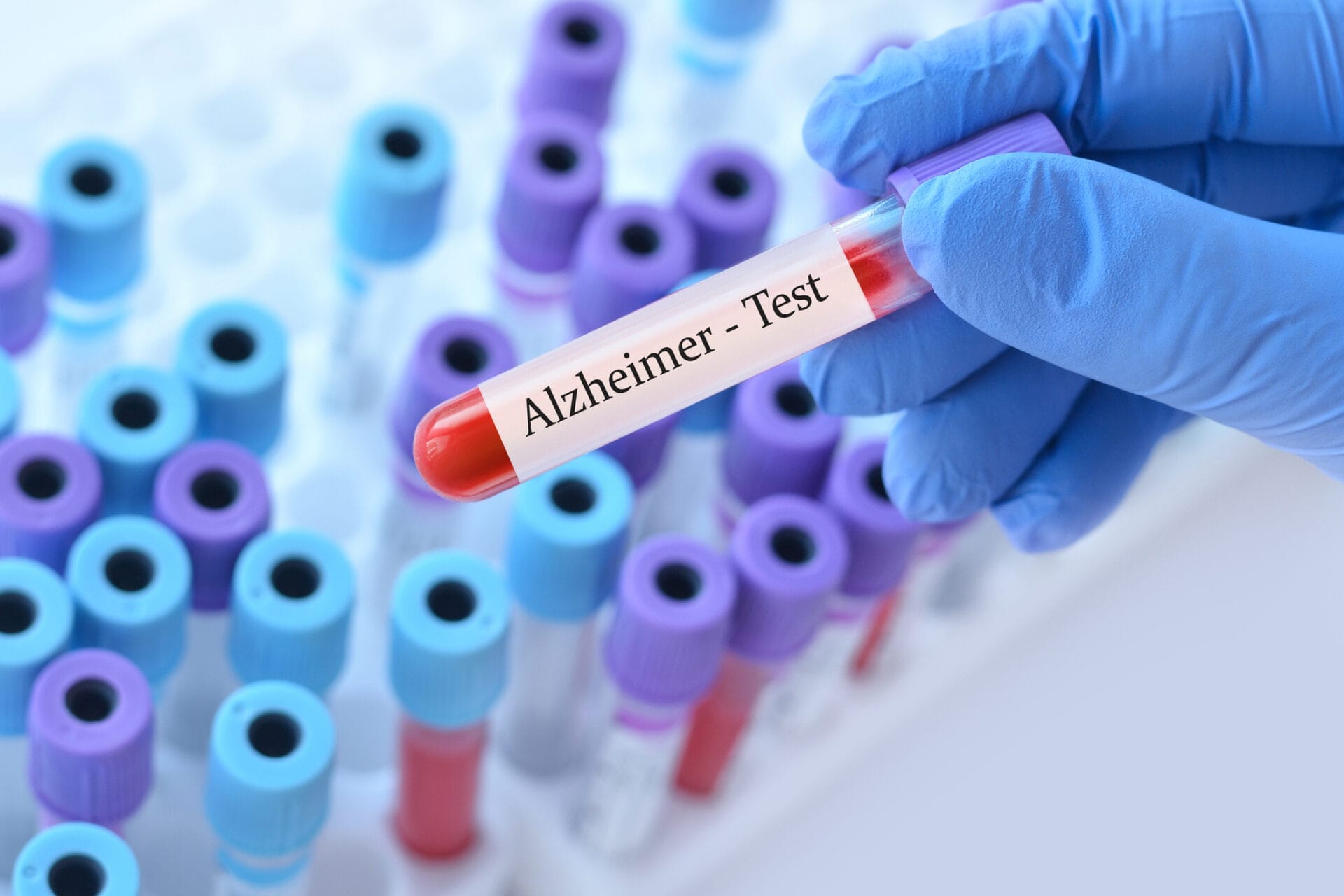Overcoming technical barriers to blood-based diagnosis of neurodegenerative disease
Sagentia Innovation’s Dr Nick Collier and Tom O'Neill consider the development of sensitive, robust, and reliable blood-based tests to revolutionise diagnosis for diseases like Alzheimer’s.
With the global burden of neurodegenerative conditions set to double in the next two decades, new strategies for prevention and treatment are needed. Early diagnosis – ideally in primary care settings, before symptoms of cognitive impairment are displayed – is a critical enabler. It allows treatment to be initiated sooner and supports interventions which may slow or even prevent disease progression.
Advances in diagnostic biomarkers
Improved understanding and targeted use of diagnostic biomarkers for neurodegenerative diseases has an important role to play in early diagnosis.
Take Alzheimer’s disease. Biomarkers found in cerebrospinal fluid (CSF) are useful for early diagnosis, but sample acquisition is invasive and expensive. It also requires highly skilled clinicians and brings the risk of complications. However, a 2019 study showed that biomarkers found in plasma correlate with the CSF and neuroimaging biomarkers currently used diagnostically to confirm Alzheimer’s disease. More recently, an article in Nature (Recent advances in Alzheimer’s disease: mechanisms, clinical trials and new drug development strategies) conceded that “Blood biomarkers offer an economical, convenient, minimally invasive, and highly accessible diagnostic alternative.”
Indeed, a study part-funded by the US National Institutes of Health found that a blood test developed for Alzheimer’s had 90% accuracy. This holds great promise for early diagnosis at the primary care level using accessible methods. But blood biomarker assays present various technical challenges which must be addressed before the vision becomes reality.

Blood tests for Alzhemier’s: assay optimisation
Alzheimer’s diagnosis is supported by measuring a combination of biomarkers. CSF biomarker diagnostic techniques focus on identifying Alzheimer’s pathologies like amyloid β (Aβ) plaques and tau tangles. These protein abnormalities disrupt normal brain function and are considered hallmark indicators of the disease. Both types of damage result in small amounts of abnormal protein leaking into the blood stream. Of the two, Aβ plaques appear earlier – sometimes decades before clinical symptoms are noticed – making them of great interest for early diagnosis using blood biomarker assays. However, biomarkers in blood/plasma are generally present at much lower concentrations compared to CSF and therefore require higher sensitivity techniques.
Test sensitivity
A specific area of focus for Alzheimer’s blood tests is the ratio of Aβ42/40 peptide fragments. But since the difference in Aβ42/40 concentration between individuals who have Alzheimer’s and those who don’t is small, diagnostic accuracy is a concern. Assay design is crucial here. Performance can be enhanced with high-accuracy fluidic handling steps and expert implementation of optical detection techniques such as chemiluminescence, microwell arrays, and multiplex fluorescence. These measures improve test sensitivity, ensuring that very small amounts of target proteins can be detected consistently and reproducibly.
Recent developments in this space include Fujirebio’s Lumipulse test for the assessment of Aβ accumulation in Alzheimer’s patients and Quanterix’s Simoa phospo-Tau 217 blood test. The former was submitted to the US Food and Drug Administration (FDA) in September 2024, and the latter was granted Breakthrough Device Designation by the FDA in March 2024.
Sample stability
A further challenge associated with Aβ42/40 quantitative assays is sample stability. Blood sample collection and pre-analytical handling require careful management to avoid impacting biomarker concentrations. Other factors – such as fasting or exercising before the sample is taken – can impact Aβ42/40 concentrations too. It may be necessary to advise patients to avoid certain activities before the blood draw to avoid false positives or false negatives. Also, true fasting status might be determined by including HBA1C and glucose in test data then flagging samples of concern. Such an approach would be similar to the measurement of haemolysis, icterus, and lipemia (HIL) in blood samples to minimise misreporting.
Reagent specificity and consistency
The reagent antibodies used to detect proteins in chemiluminescent or electrochemiluminescent immunoassays must achieve high standards of specificity, sensitivity, and stability. Finding antibodies that are sensitive enough to detect tiny amounts of the target protein but specific enough to ignore everything else can be a challenge. Batch to batch variability compounds the issue and must be addressed to improve the performance of blood biomarker assays for Alzheimer’s diagnosis.
Using multiplex assays and combinations of antibodies can overcome some of the limitations linked to specificity. Consistency on the other hand requires batch to batch calibration and reliable reference materials.
To improve specificity a wide selection of biomarkers are being investigated. These include Neurofilament Light (NFL), neurogranin, BACE1, synaptotagmin, SNAP-25, GAP-43, synaptophysin, sTREM2, YKL-40, and D-serine. With an array of potential biomarkers that may show complex relationships across disease types and progression, researchers are investing machine learning to classify patients. These are currently in their infancy, but we expect them to become more common and be combined with other parameters such as sex, age, education, and imaging data over the coming years.
Assay standardisation
For Alzheimer’s blood tests to be used in primary care environments, they must be standardised with diagnostic techniques used in other settings. Results should be consistent, irrespective of which method is used, and where or when it is performed. This demands the development and validation of cutoffs – in other words, threshold values used to classify a result as positive or negative – that translate across different methods. At present, certified reference materials for blood biomarkers are still in development and test methods are not commutable. So, cutoffs need to be based on clinical studies with the specific assay technology and validated on the target patient population.

Improving the prognosis of Alzheimer’s patients
Alzheimer’s Disease International says the annual global cost of dementia is now above US$ 1.3 trillion and expected to rise to US$ 2.8 trillion by 2030. Moving diagnostic testing from specialist clinics to primary care settings will make earlier diagnosis and treatment of Alzheimer’s more achievable. Advancements in blood-based biomarkers which could facilitate this are ongoing. Micro RNAs are now emerging as a potential early indicator which could be measured alongside Aβ42/40 peptide fragments. Combined with drugs such as Kisunla and Leqembi that delay the onset of and/or slow cognitive decline, these developments could transform and extend life for people with the disease. Economic impacts will also be reduced, in terms of costs associated with informal care, social care, and direct medical care.
Leveraging blood-based biomarkers for early diagnosis of Alzheimer’s at the primary care level requires significant improvement of detection methods. As well as achieving high levels of sensitivity, specificity, and stability, steps must be taken to reduce the cost and increase the throughput of diagnostic tests. This will require focused attention and investment, but the outcomes could be game changing.
How Sagentia can help
Sagentia has the scientific and technical capabilities to fast-track the development of assays for blood-based diagnosis of Alzhemier’s and other neurodegenerative conditions. Our experience includes the design of microfluidics, consumables, and instrumentation for high-sensitivity immunoassays (including digital immunoassays) as well as chemiluminescence and multiplex fluorescence assays. We have also developed solutions for maintaining the stability of reagents during storage, both on-the-shelf and on-board the diagnostic instrument. Another area of expertise is the detection of pre-analytical errors in patient samples and the design of user steps, assay workflows, and fluidics.
If you’re looking to accelerate and optimise the development of diagnostic techniques, we’d love to help. Contact us here.
Author: Dr Nick Collier, Chief Technology Officer
For over 25 years, Nick has dedicated his career to translating research concepts into practical medical products. He has gained extensive experience in the diagnostic market, working with high-sensitivity immunoassays, haematology, microbiology, clinical chemistry, molecular assays, sequencing, and histopathology.
Nick's background in biochemistry, physics, and engineering allows him to lead teams in combining assays, microfluidic consumables, and instruments into effective commercial solutions. His work aims to advance medical technology, improve patient care and diagnostic accuracy.
Contact us